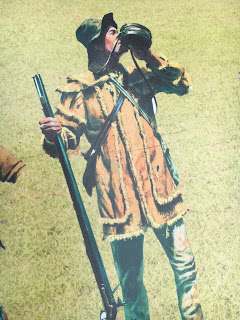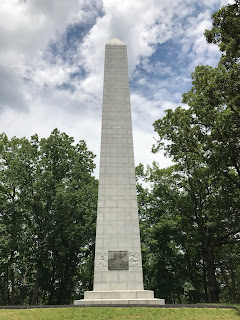Our association with Edenton comes from our Ming ancestors, who were early inhabitants of the area. (The following information is a result of the research of Ming descendants, including my cousin Paul E. Ming, who generously shared his research results with me.) Joseph Ming, son of David and Elizabeth (Carter) Ming of Bermuda, was the first Ming to live in North Carolina, having been granted 200 acres for bringing in seven settlers, including his son Thomas. Joseph Ming was a seafaring man, master of the sloops, Tyrall and Ruth of North Carolina. Records show that he came to Bath County NC in 1701; early maps show Bath County on the south side of Albemarle Sound, while later records indicate that Joseph owned land on the Yeopim River in Chowan County on the north side of the Sound.
While the Ming family first settled in Bath County, sometime after 1700 the sons of the elder Joseph are living in Chowan County, perhaps after the death of their father in 1707 or an Indian massacre that occurred in Bath County in 1711. In 1719 Joseph bought 150 acres of land in Chowan County. Sometime before 1722 Joseph married Rachel Ward, because in that year "James Ward deeded to planter Joseph Ming for a marriage already solemnized between Joseph and Rachel gave two plantations westward of Yoppim River Bridge, being 108 acres and 200 acres with cattle in Bridge Neck." By 1759 Joseph Jr. had acquired more than 508 acres of land in Chowan County.
Joseph and Rachel had six children: Thomas (born about 1734), Sarah, James, Mary, Joseph (III), and Annarita. Joseph's will, signed 1 December 1750, names his heirs as wife Rachel; sons Thomas and Joseph; daughters Sarah Wilkins, Annarita Collins, and Mary Ming (later Haughton); and grandsons, Joseph Wilkins and Thomas Collins. Joseph died by 16 July 1751 when an inventory of the estate was taken.
Our ancestor is Joseph's son Thomas. His birth date of 1734 is estimated because Joseph's will of 1750 stated that he was not yet 18 and provided three more years of schooling for him. By 1752 he took over administration of his father's will from his brother Joseph who was in ill health, so at that point he must have been 18. Thomas married Delilah (probably Felton) in the early 1760's as their son James was born about 1765. Thomas was a miller; he owned a grist mill on a branch of the Yeopim River which divides Chowan from Perquimans County. It was paid for in full by 5 December 1766 and sold on 21 March 1768. During the 1760's and 70's Thomas and Delilah had seven children: sons Joseph, James, Thomas Jr., and Willy; and daughters Mary, Rachel, and Penelope.
By 1782 the family had moved to Edenton. In that year Thomas purchased a small house in town. According to tax records, he also retained ownership of 200 acres in Chowan County. In the first census of 1790 Thomas's household included two males over 16, one male under 16, four females, and ten slaves. Thomas made his will 6 November 1792 and had passed away by 1796 or early 1797. Marriages of Thomas and Delilah's children include: Joseph to Sarah Beasley; James to Ann Beasley (our ancestors); Thomas Jr. to Sarah Burkett; Mary to a man named Warburton; Rachel to Harry Gregory; and Willy to Elizabeth Roberts.
The Beasley family name appears as early as 1675 in what is now Perquimans County NC. Ann Beasley was the daughter of Thomas and Martha Beasley, who married after 1754 in Perquimans County. Thomas had died in 1790 as Martha appears as head of household on the 1790 census in Chowan County. Daughter Ann married James Ming on 23 February 1790. Martha died in 1806 and her will was probated in Chowan County in 1809. It listed children Sarah and husband Joseph Ming, Ann and husband James Ming, Samuel, Joseph, and Elizabeth (Mrs. Haughton). The Haughtons were a large family that lived in the same area as the Ming and Beasley families near the Yeopim River, which separates Chowan and Perquiman counties.
Samuel, the eldest son of James and Ann Beasley Ming, was born in 1792. Thomas (our ancestor) was born 14 February 1796. James had his own farm by 1797 when his father died, according to a suit filed against him by his mother (!) for having possession of three of her slaves. After this line of Mings having lived in Chowan County for over a century, James left the county sometime after 1815. By the 1820 census James and his family were living in Limestone County, Alabama. Some of the Ming families remained in Chowan County for several more years, but they slowly died off or moved away. By the end of the 1800's the Ming name had disappeared from the census records in Chowan County.
My brother and I had been excited about visiting Edenton for several years, having heard about it from our cousin Paul Ming. My brother found a connection to Edenton that he wasn't even aware of until we visited this summer. He teaches this political cartoon, published in London in March 1775, to his 8th grade American history students, but he didn't realize that the event that it satirizes happened in Edenton.
 |
| Image from North Carolina History Project |
Our first sightseeing stop was the Penelope Barker House, which is Edenton's Welcome Center and the home of the woman responsible for the Edenton Tea Party, the subject of the above cartoon.
 |
| Photo from Edenton Historical Commission |
Penelope had been widowed twice before marrying lawyer Thomas Barker in 1757. In his capacity as agent for the North Carolina Colony, Thomas traveled to London in 1761 and was stranded there until 1778 because of the British blockade of American ships. For seventeen years Penelope managed the family's affairs in North Carolina and became involved in the protest against British taxation. After writing a public statement encouraging a boycott of British tea and cloth, she invited 50 women to a "tea party" on October 25, 1774. According to the blog, "History of American Women," Penelope said, "Maybe it has only been men who have protested the king up to now. That only means we women have taken too long to let our voices be heard. We are signing our names to a document, not hiding ourselves behind costumes like the men in Boston did at their tea party. The British will know who we are." While the British ridiculed them as loose women and bad mothers, the signers were praised by the colonists.
Among the names of the 50 women who signed the Resolutions of the Edenton Tea Party were: Elizabeth Beasly, Sarah Beasley, Anne Haughton, and three women named Elizabeth Roberts. It's not known exactly how these women might have been related to our Ming/Beasley ancestors.
After visiting the Roanoke River Lighthouse, one of the most photo-worthy sights in Edenton, we took a boat tour in the estuary.
I found out that an estuary is, according to Wikipedia, "a partially enclosed coastal body of brackish water with one or more rivers or streams flowing into it, and with a free connection to the open sea." Our tour guide, a retired submariner, took us on a tour of the coastal sights of Edenton.
 |
| The Liber-Tea |
We saw the Barker House and other residences from the vantage point of the estuary.
We saw the "Dram Tree," a cypress tree that has been standing in the Edenton harbor for centuries. It became the custom for a ship entering the harbor at Edenton to place a bottle of Jamaican rum in the roots of the tree. Ships going out of the harbor stopped at the tree for the crew members to drink a dram, thus ensuring good luck for the journey.
And in another cypress tree out in the estuary we saw a huge nest, and my brother was the first to see the eagle-size bird that built it. Our guide explained that it was an osprey, and the one in the nest was the male, and the one we saw flying and hunting was the female.
 |
| Osprey nest in cypress tree |
Our last stop for photos was the Chowan County Courthouse. Built in 1767, it is the oldest still-functioning courthouse in the United States.
I turned to look back across the green at the estuary, and this scene took my breath away. Not the first or last time that would happen on this trip.
The day was not over yet. After a nerve-wracking detour around the naval base in Norfolk (and the amazing sight of a battleship being loaded by crane), we arrived in Colonial Williamsburg. After a delicious dinner at Berret's Seafood Restaurant, across the street from William and Mary College, we walked through Merchants Square and met a friend of Tim's and her husband for a stroll and drinks at Josiah Chowning's Tavern in Colonial Williamsburg. The atmosphere was cozy, and the sing-along was so fun!
 |
| Berret's Seafood Restaurant |
 |
| My yummy meal at Berret's |
 |
| Sing-along at Josiah Chowning's Tavern |

















